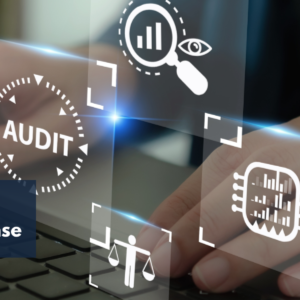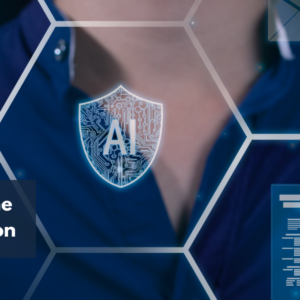This is the sixth blog post for NanoMatriX’s AI Governance Series.
Artificial Intelligence is rapidly transforming various industries, becoming an integral part of our daily lives. However, the journey of AI is not without challenges. 85% of AI projects fail, often due to poor data quality and a lack of understanding of AI’s capabilities. These failures can have multiple consequences, including financial losses and diminished user trust. For instance, in 2023, OpenAI’s ChatGPT experienced 173 outages, affecting users for over 427 minutes. Such incidents highlight the need for effective strategies in continuous monitoring, data governance, and compliance.
As AI systems grow more complex, ensuring their reliability and performance becomes important. Continuous monitoring allows companies to track AI performance in real-time, while strong data governance ensures that the data used is accurate and secure. Compliance with regulations further safeguards against potential risks.
Let’s explore how to optimize AI performance through these essential practices, helping companies deal with AI successfully.
Continuous Monitoring For AI Optimization
Continuous monitoring is essential for keeping AI systems reliable and effective. It involves regularly tracking the performance of your AI models and identifying issues before they impact operations. For instance, data drift, which is when the data your model receives changes over time, can cause predictions to become less accurate. By monitoring your system, you can catch such issues early and make necessary adjustments.
To implement continuous monitoring effectively, several key components should be considered:
- Real-Time Data Analysis: This involves collecting data as it happens and analyzing it instantly. It allows teams to see how well the AI system performs at any moment.
- Performance Metrics and KPIs: Establishing clear metrics and key performance indicators (KPIs) is essential. These benchmarks help measure the success of the AI system and guide improvements.
- Feedback Loops for Improvement: Continuous monitoring should include mechanisms for feedback. This means using the data collected to refine algorithms and enhance performance over time.
Businesses that invest in continuous monitoring see significant benefits. According to a study, organizations with effective monitoring practices experience fewer system failures and up to 40% faster problem-resolution times. By keeping a close eye on performance, companies can maintain the integrity and efficiency of their AI systems while building trust with their users.
Data Governance: Foundation for Responsible AI
Data governance ensures that the data used by AI systems is accurate, secure, and trustworthy. AI models rely on high-quality data to perform well. The AI system’s output can be inaccurate or harmful if the data is flawed, incomplete, or biased.
For example, a McKinsey study found that 70% of AI leaders experienced issues because of poor-quality data. This shows how vital governance is for ensuring that AI systems meet business needs and ethical standards.
Best practices for data governance include:
- Clear Policies: Establish rules for collecting, storing, and using data.
- Regular Audits: Review datasets periodically to ensure accuracy and relevance.
- Access Control: Limit data access based on roles to protect sensitive information.
Effective governance also reduces risks. It helps businesses comply with privacy laws like GDPR and ensures AI systems respect user rights. For example, by implementing strong data governance, a healthcare provider reduced data errors by 30% and improved patient outcomes.
By focusing on strong governance practices, businesses can build a solid foundation for their AI systems and achieve better results.
Compliance in AI Systems Different industries have various compliance requirements. These can include regulations like the General Data Protection Regulation (GDPR) in Europe or the California Consumer Privacy Act (CCPA) in the United States. These laws are designed to protect personal data and ensure that organizations handle it responsibly.
Companies must understand which regulations apply to them. This understanding helps them avoid legal issues and build trust with their customers. Non-compliance can lead to hefty fines and damage to reputation. This makes it important for businesses to stay informed about relevant laws.
Implementing Compliance Measures
To ensure compliance, companies should take several key steps:
- Conduct a Compliance Assessment: Start by evaluating current practices against applicable regulations. Identify gaps where improvements are needed.
- Develop Policies and Procedures: Create clear policies that outline how data should be collected, stored, and used. Ensure these policies align with compliance requirements.
- Train Employees: Educate staff about compliance policies and the importance of following them. Regular training helps everyone understand their role in maintaining compliance.
- Monitor Compliance Continuously: Compliance is not a one-time effort. Companies should regularly review their practices and adjust as needed to comply with changing regulations.
Role of Audits and Assessments
Regular audits are vital for maintaining compliance. These assessments help organizations identify risk areas and ensure policies are followed. Audits can be internal or conducted by third-party experts who objectively view compliance status.
By implementing strong compliance measures, companies can mitigate risks associated with data handling. This protects them legally and enhances their reputation in the market. Customers are more likely to trust companies prioritizing compliance, leading to stronger relationships and increased loyalty.
Documentation: Supporting Compliance and Long-Term Success
Clear and accurate documentation is essential for maintaining compliance and improving AI systems over time. It serves as a record of how your systems operate, the data they use, and the steps taken to ensure security and compliance. Without proper documentation, it becomes harder to address issues or meet regulatory requirements.
Compliance documentation is particularly important when preparing for audits. For example, regulators may require detailed records of how data is collected, stored, and processed. Proper documentation ensures that businesses can provide this information quickly and accurately.
Using AI tools for documentation can save time and reduce errors. These tools can automatically generate reports, track system changes, and organize records for compliance purposes. Research shows that businesses using automated documentation tools can reduce compliance-related workloads by up to 50%.
By prioritizing documentation, companies not only meet regulatory standards but also create a strong foundation for future improvements. Well-documented systems are easier to monitor, update, and scale, ensuring long-term success.
Integrating the Three Pillars for Optimal AI Performance
Continuous monitoring, data governance, and compliance are interconnected pillars that work together to ensure AI systems perform reliably and ethically. Addressing these areas separately can leave gaps, but combining them creates a strong framework for success.
For example, continuous monitoring can identify issues like performance drifts, but without proper data governance, the root cause, poor-quality data, may remain unresolved. Similarly, compliance ensures that AI systems meet legal standards but rely on monitoring and governance to enforce those standards effectively.
Steps to integrate these pillars include:
- Unified Frameworks: Develop a strategy that connects monitoring, governance, and compliance processes. This ensures all areas work together seamlessly.
- Automation Tools: Use AI-driven tools to automate monitoring, data audits, and compliance checks. This saves time and reduces human errors.
- Collaboration: Involve cross-functional teams, including data scientists, compliance officers, and IT staff, to ensure all aspects are covered.
For instance, a multinational bank combined real-time monitoring tools with strong governance policies and compliance checks. This approach reduced operational risks and helped them meet strict financial regulations.
By integrating these three pillars, businesses can optimize their AI systems, reduce risks, and create more reliable outcomes.
Practical Takeaways for Business Owners and Managers
For businesses to fully benefit from AI systems, they need a clear monitoring, governance, and compliance plan. Here are some practical steps to get started:
- Set up real-time monitoring: Use tools that track performance metrics like accuracy, data drift, and system errors. Regular monitoring helps catch issues early and ensures systems run smoothly.
- Implement strong data governance: Create policies for data privacy, security, and access control. Ensure your team understands and follows these guidelines to maintain data integrity and meet regulatory requirements.
- Conduct regular audits: Schedule internal audits to identify weaknesses and prepare for external compliance checks. Use audit findings to improve processes and reduce risks.
- Maintain detailed documentation: Keep records of how your AI systems operate, how data is managed, and the steps taken for compliance. Consider using AI tools to simplify this process.
- Focus on continuous improvement: Use insights from monitoring and audits to update and refine your AI systems. Stay informed about new technologies and evolving regulations to keep your systems efficient and compliant.
By following these steps, business leaders can build reliable AI systems that drive success while staying aligned with compliance requirements.
Challenges and How to Overcome Them
Implementing continuous monitoring, data governance, and compliance comes with challenges. Businesses often face resource limitations, complex regulations, and evolving AI systems that require constant attention.
One common challenge is the lack of skilled staff to manage AI systems. A 2023 report found that 48% of organizations struggle to find qualified professionals for AI-related roles. Another issue is the complexity of global regulations, as different countries have varying requirements for AI compliance and data protection.
Here’s how businesses can overcome these challenges:
- Leverage Automation: Use tools that automate tasks like monitoring performance, auditing data, and tracking compliance. This reduces the burden on teams and ensures consistency.
- Invest in Training: Provide staff with the skills they need to manage AI systems effectively, including knowledge of regulations and governance practices.
- Seek Expert Support: Partner with consultants or specialized platforms to help navigate complex regulations and optimize processes.
By addressing these challenges strategically, businesses can unlock the full potential of their AI systems while staying compliant and efficient.
Enhance Your AI Systems with NanoMatriX’s Continuous Monitoring and Improvement Course!
Staying ahead in AI optimization requires continuous learning and adaptation. NanoMatriX’s AI Continuous Monitoring, Improvement, and Documentation course is designed to help businesses build and maintain high-performing AI systems. This course covers essential topics like real-time monitoring, data governance, and ensuring compliance with ever-evolving regulations.
By enrolling, you’ll gain the knowledge to:
- Guarantee Data Quality: Learn how to ensure the integrity and quality of your data, which is vital for accurate AI performance.
- Understand Data Governance: Gain insights into practices that help manage data security and privacy.
- Conduct Internal Audits: Acquire hands-on experience in performing internal audits and preparing for external assessments, ensuring your organization meets compliance standards.
- Utilize AI Document Creators: Discover how to use AI document creators for efficient compliance documentation, making your processes smoother and more reliable.
This course is perfect for AI professionals, compliance officers, and business leaders who want to strengthen their AI systems while ensuring they remain ethical and compliant.
Ready to take your AI systems to the next level? Learn more and enroll today!
Read the seventh blog post for NanoMatriX’s AI Governance Series here.
About NanoMatriX Technologies Limited
NanoMatriX is a specialist in providing document and brand protection solutions. To solve our customer’s problems, we provide the following product and service categories:
- Brand-/document protection platforms
- Custom Software development
- Cybersecurity services
- Anti-counterfeiting products
- Consulting services
The competitive advantages of NanoMatriX are:
- Two decades of experience helping brand owners and government agencies fight product and document crime worldwide.
- A unique combination of rare-to-find skills in linking physical overt, covert, and forensic security features with secure digital features.
- Proven rigorous application of top cyber security and data privacy protection standards.
- Multi-lingual, multi-cultural, and collaborative corporate culture.
NanoMatriX Technologies Limited is committed to the highest cyber security standards, data privacy protection, and quality management. Our systems are certified and compliant with leading international standards, including:
- ISO 27001: Ensuring robust Information Security Management Systems (ISMS).
- ISO 27701: Upholding Privacy Information Management Systems (PIMS) for effective data privacy.
- ISO 27017: Implementing ISMS for cloud-hosted systems, ensuring cybersecurity in cloud environments.
- ISO 27018: Adhering to PIMS for cloud-hosted systems, emphasizing privacy in cloud-hosted services.
- ISO 9001: Demonstrating our commitment to Quality Management Systems and delivering high-quality solutions.















Recent Comments